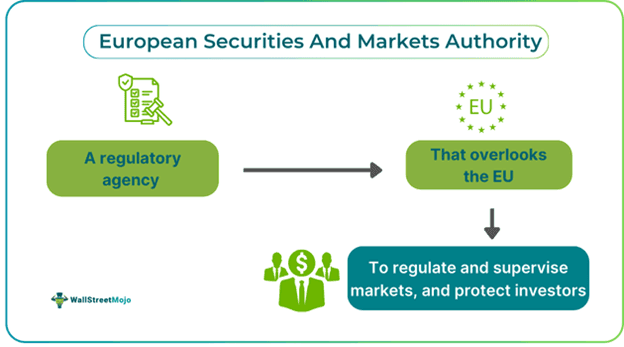Table Of Contents
Key Takeaways
- The European Securities and Markets Authority, established in 2009, is the EU's regulatory and supervising agency. Its goals are to promote financial stability, strengthen the EU market, and protect investors.
- The ESMA promotes fair markets, assesses risks, and develops regulations to ensure efficient, accessible markets.
- The ESMA coordinates the international market, protects investors, provides an information hub, and monitors the market.
- Credit rating agencies, securitization, and trade repositories are some of the entities under the ESMA's supervision. Additionally, the ESMA oversees data reporting service providers, ensuring the accuracy and transparency of market data.
History
The ESMA was established in 2009. It was established as per the recommendations of the de Larosière report. The report recommended the establishment of a decentralized network (the European system of financial supervision. The ESMA began its operations in the year 2011 (January 1 ) as per the founding regulation. It had replaced the committee of European securities regulators that had NCAs, which played a key role in promoting consistent supervision all over the European Union. It also provided advice to the European Commission.
Role
Given below are some of the roles it has in the financial market and the protection of its investors.
- It acts as a regulator and develops the rule book of securities legislation in Europe.
- It promotes the fair treatment of investors across the EU.
- It is a supervisor that focuses on regulating and supervising investors, products, and services in the financial market.
- It is a market monitor and creates equal conditions of competition for service providers in the market.
- It is a coordinator and coordinates international collaboration of regulations.
- It is a protector and identifies the potential risks in the system and threats to the financial system's stability.
- It acts as an information hub. The agency coordinates the actions of securities supervisors and adopts emergency measures in cases where they are needed.
- It is a defender of the Union’s interests and acts as an advisor.
Initiatives And Mandates
The ESMA undertakes activities such as
- Investment and management services such as crowdfunding, retail distribution and financial products.
- It involves itself in issuer disclosure, including financial reporting.
- It regulates benchmark administrators and credit rating agencies.
- Its supervisors are the central counterparties. It looks after the data reporting service providers dealing with trading, central securities depositories, trade repositories and securitization repositories.
The ESMA's recent initiative is the Digital Operational Resilience Act (DORA). It was established on January 16, 2023, and is intended to continue until January 17, 2025. Its goal is to strengthen digital operational resilience. The ESMA's mandates differ according to the initiatives it adopts.
While ESMA works within several mandates, two key thematic drivers shape its efforts: sustainable finance and technological innovation. European Securities and Markets Authority guidelines adapt depending on the initiative, ensuring effective regulation and supervision of the financial market. ESMA focuses on fostering sustainability, promoting resilience across all sectors, and placing a strong emphasis on cybersecurity.
Who Must Comply With Mandates?
The entities supervised by the ESMA are given below and shall comply with their mandates.
- Credit rating agencies
- Securitization and trade repositories
- Data reporting service providers
- Benchmark administrators
- Tier 2 central counterparties (outside the EU)
- European green bonds
- Date reporting service providers


